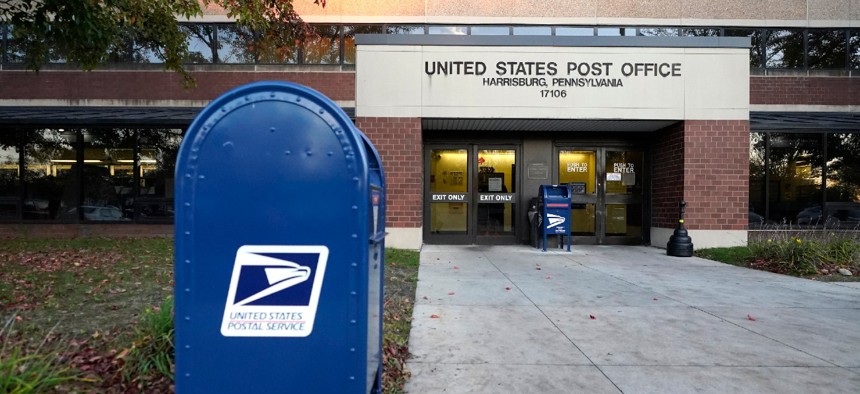
Julio Cortez / AP
USPS Should Outsource More Post Offices and Request Subsidies, IG Says
Postal management said only it was "eager to consider" proposals to get the agency out of the red.
The U.S. Postal Service should tap into already authorized subsidies for low-revenue post offices and outsource more of its retail operations to third-party businesses like grocery stores, according to recommendations from the mail agency’s auditor.
The suggestions would restart battles USPS has fought in recent decades, hitting on key pressure points that have rankled stakeholders and led to significant pushback. The Postal Service’s inspector general said management should still consider the changes as they would help improve the agency’s weak financial situation, though far more significant reforms would still be required to get it out of the red.
Use of post offices has declined by one-third since 2004, the IG found in its review, though USPS has barely tinkered with its retail footprint in that time. The agency still maintains 31,000 post offices across the country, with the total only dropping by 5% over that timespan. Postal management undertook several efforts to cut the retail facilities in that period, but they mostly fizzled out and USPS has essentially abandoned closing any of them since 2012.
After facing significant pushback from lawmakers and other stakeholders, the Postal Service compromised by leaving rural post offices open while slashing their hours. Even that effort has slowed. While USPS continues to track post office performance to find individual facilities that could see hours reduced, it has not done so for several years. It identified 3,600 such facilities in fiscal 2019 without taking any action on them. The hour reductions and potential closures have become a flashpoint between management and Congress and USPS has paused its efforts as it sought to find agreement on comprehensive legislative reform.
More than four-in-10 post offices do not cover their costs, with those overwhelmingly coming from rural areas. About 60% of rural post offices operate underwater, though their performance was more than offset by their suburban and urban counterparts. Overall in fiscal 2019, post offices generated $10.2 billion in revenue while costing USPS $5.2 billion. About half of all the facilities are in rural areas, where just 16% of the U.S. population lives.

The IG noted rural post office growth spiked in the 19th century when USPS did not make rural home deliveries, leading it to maintain 75,000 post offices in 1900. That number continued to decline over the next 100 years.
The auditors cautioned USPS against simply trying to cut its way into making its network more profitable.
“Efforts to optimize the retail network cannot focus solely on the reduction of service hours or closure of offices,” the IG said. “The Postal Service has other options to either increase retail network funding or reduce costs.”
In 1970 when Congress overhauled postal operations, it created a provision allowing USPS to request $460 million to offset losses it expected the agency to incur by maintaining rural services. The Postal Service has not requested the funds since 1982, which the IG noted meant it has potentially foregone more than $25 billion. Postal management responded that it prefers to remain self-sufficient and Congress may decline its requests anyway. USPS often proudly highlights that it does not receive appropriations in its external communications and many lawmakers have shown an aversion to providing it with direct funding. Still, Congress authorized and USPS accepted a $10 billion cash infusion as part of COVID-19 relief.
The inspector general also noted just 9% of USPS retail operations are physically located in third-party businesses, a much lower rate than many of its foreign counterparts. Increasing that outsourcing rate would lower staffing and operational costs for the agency, the IG said. A recent effort to partner with Staples to house postal retail services led to an outcry from unions and lawmakers and USPS ultimately ended the partnership after prolonged legal battles.
Angela Curtis, USPS’ vice president for retail and post office operations, did not comment directly on the outsourcing proposal, but said management found the IG’s recommendations “informative.” She noted USPS has incorporated some of the suggestions into its business model—such as increasing other governmental services offered at post offices—but it remains legally barred from providing many non-postal offerings. Curtis vowed to keep an open mind in considering the IG’s proposals, however.
“Postal management is always eager to consider models that could benefit in maintaining a comprehensive and financially sustainable postal network,” Curtis said.
In his recently unveiled 10-year business plan to put the Postal Service on firmer financial footing, Postmaster General Louis DeJoy proposed further cutting hours at “low traffic” post offices. The suggestion was immediately derided by postal unions and congressional Democrats.
The economic justification for slashing retail offerings may have taken a hit in recent months. During the pandemic, USPS saw a 21% spike in retail package revenue. A $525 million overall year-over-year increase marked a reversal of the longstanding trend of declining post office revenue.
Additionally, the IG also said in echoing a refrain often heard from postal advocates and stakeholders, “post offices still serve a critical role in American communities.”







